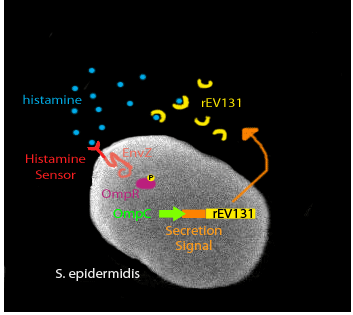Team:Brown/Project All Together
From 2009.igem.org

- Mast cells release histamine during the allergic response.
- Histamine binds to our re-engineered histamine receptor.
- This receptor’s intracellular kinase domain EnvZ phosphorylates transcription factor OmpR.
- OmpR turns on transcription of DNA under the OmpC promoter.
- The genes for rEV131 with its attached secretion signal are transcribed.
- After translation, the signal peptide causes rEV131 to be secreted into the extracellular fluid.
- rEV131 sequesters histamine, preventing it from interacting with the human histamine receptors.
- The transcription and secretion of rEV131 continues as long as histamine is present in the extracellular fluid. When histamine concentration returns to its pre-allergic response state, production of rEV131 stops because the initiating ligand histamine is no longer present.
 "
"

